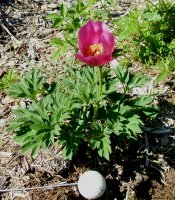First, sorry for the gap. The weblog server was down when I attempted to post during the past 2 days. But, one can expect the odd gap in the weeks to come as I try to fit in a bit of work between watching World Cup Football on tv... Of course, if it continues to rain here as much as it has the past 10 days I should have lots of indoor time to spend on the computer.
______________________________

This was one of the first species of peony that I came to grow, from seed obtained through the seed exchange of the Devonian Botanical Garden near Edmonton Alberta. In my early ignorance of all the rest of the species, I used to think it was one of the

earliest of peonies to bloom. Now of course we all know better, after writing and reading at this weblog.
Although I've been growing it for over a decade it is only recently that I started to

see variations in flower colour, in plants grown from seed collected off my plants and in seed obtained from elsewhere.
Common name: Veitch's Peony.
Paeonia veitchii has been an easy and low

maintenance plant for me, responding well to neglect. Sturdy stems produce an almost dome-shaped bush form by the age of 6 or so; height: 2-3 ft.
All the species we've looked at up to now

have only one flower per mature stem. Veitchii however has side-buds, some of which do not mature but usually each stem will put out 3 to 5 flowers. This means a longer bloom period, 2 to 3 weeks as opposed to about 1 week for the earlier

species.
It's native to NW China (in the provinces of Gansu, Sichuan and Shensi), where it grows in subalpine meadows and scrub, and to mountain grasslands. In my gardens it is quite adaptable, growing decently in all my bed sites, although flowering less in the woodland bed and remaining shorter more compact in the open field than it is in partial shade.
Some plants have foliage with an interesting etched-like appearance to the veining, while that of others appears smooth. The foliage maintains a great appearance right up to the first frost with no ornamentally interesting colour-change.

The deep red flower here is from seed obtained from a seed exchange as the "late-flowering form" of
P veitchii; no mention of any departure from the usual pink flowers. Well, it chooses to flower at the same time

as all my other
veitchii's (starting 31 May this year) but has this intensely deep red bud that any rose would be proud to have, and flowers that age to crimson. An exciting variant!

These last two photos are of a probable hybrid grown from seed from a seed exchange. The foliage is incredibly finely-cut, almost as fine as tenuifolia. The flower is a very good red with a slight bluish tinge.

 In no particular order, here are a few of the seedlings of Paeonia lactiflora (some may be hybrids) which flowered for me for the first time this year. Seeds were from a broad spectrum of seed parents, bee-pollinated (back in the days before the
In no particular order, here are a few of the seedlings of Paeonia lactiflora (some may be hybrids) which flowered for me for the first time this year. Seeds were from a broad spectrum of seed parents, bee-pollinated (back in the days before the  honey-bee hive got killed by a bad winter). Most have self-supporting stems but a few, especially the large doubles, are weak-stemmed and are better with staking (easier to miss with the lawnmower, at least). Most are sweetly fragrant and most
honey-bee hive got killed by a bad winter). Most have self-supporting stems but a few, especially the large doubles, are weak-stemmed and are better with staking (easier to miss with the lawnmower, at least). Most are sweetly fragrant and most  have sidebuds which extend the duration of the bloom period.
have sidebuds which extend the duration of the bloom period.















































